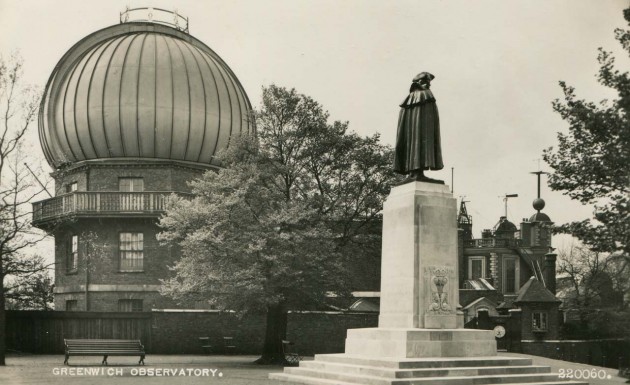…where east meets west
- Home
- Brief History
- The Greenwich Meridian
- Greenwich
(1675–1958) - Herstmonceux
(1948–1990) - Cambridge
(1990–1998) - Outstations (1822–1971)…
- – Chingford (1822–1924)
- – Deal
(1864–1927) - – Abinger
(1923–1957) - – Bristol & Bradford on Avon
(1939–1948) - – Bath
(1939–1949) - – Hartland
(1955–1967) - – Cape of Good Hope
(1959–1971)
- Administration…
- – Funding
- – Governance
- – Inventories
- – Pay
- – Regulations
- – Royal Warrants
- Contemporary Accounts
- People
- Publications
- Science
- Technology
- Telescopes
- Chronometers
- Clocks & Time
- Board of Longitude
- Libraries & Archives
- Visit
- Search
The unveiling of the Wolfe Statue (5 June 1930)
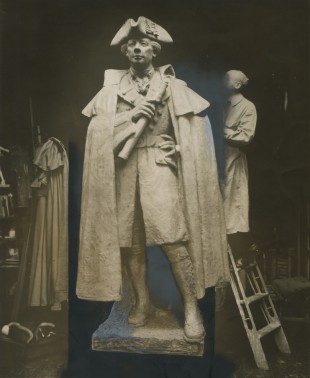
Robert Tait McKenzie putting the finishing touches to the Wolfe Statue in 1928 prior to it being cast in bronze. The press photo from which this scan was taken, was inked over so that it could be printed in cropped form with McKenzie omitted from the scene
Wolfe, whose parents lived in Macartney House on the western edge of Greenwich Park, died in the battle as did Montcalm. After the battle, Wolfe’s body was repatriated and is buried nearby in St Alfege Church.
The unveiling ceremony was attended by numerous dignitaries and broadcast both at home and in Canada to where it was relayed by the Canadian Beam Service. Amongst those who attended were Robert Tait McKenzie, the Astronomer Royal (Sir Frank Dyson), Field-Marshal the Duke of Connaught (Prince Arthur), the First Lord of the Admiralty (Albert Victor Alexander) and the society hostess Mrs. Ronald Greville. A longer list (as published in The Times) is given below. The Secretary of State for War (Tom Shaw) was also expected to attend, but appears to have been unable to do so. Click here to view a souvenir programme printed on a napkin (from the Greenwich Society website).
The sculpture was given a grade II listing in 1973. Click here for details.
Pictures from the unveiling ceremony
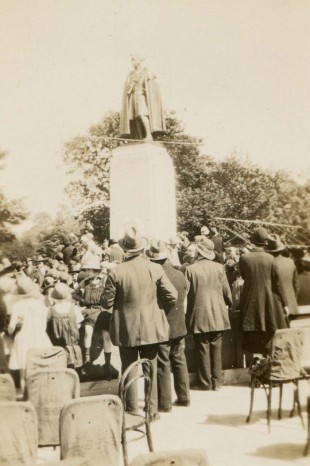
Prior to its unveiling, the statue had been swathed in flags to conceal it from view. In this photograph, the ceremony is over and the crowd have moved forward to gain a closer look
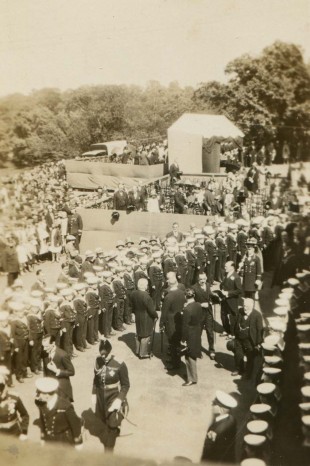
The principal guests congregated at the Observatory before proceeding, accompanied by a sequence of fanfares, to the covered pavilion. This picture appears to have been taken shortly after the ceremony had ended
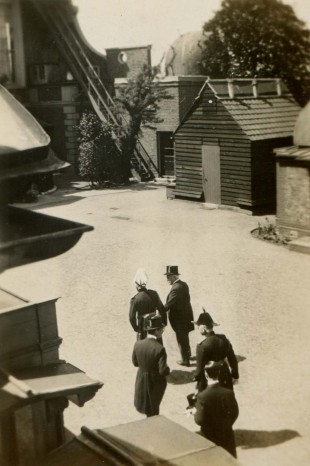
The Duke of Connaught (wearing the fancy hat) and the Astronomer Royal, Frank Dyson, lead the way towards Flamsteed House
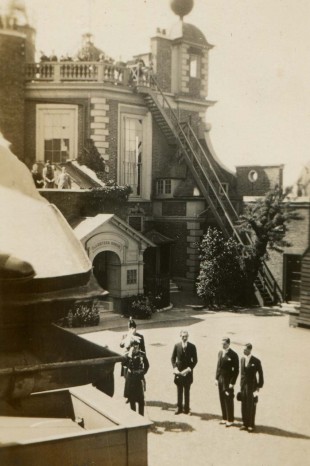
In this photo, the guests appear to have stopped to listen to Dyson explaining something to them while the Observatory staff look on from a distance
Contemporary account from The Times
A full account of the day’s activities was published (without pictures) in The Times on 6 June 1930 (p.11). The following is a transcript:
THE WOLFE STATUE
GIFT OF UNITED CANADA
UNVEILING IN GREENWICH PARK
The Marquis de Montcalm unveiled in Greenwich Park yesterday a statue of his great ancestor’s great adversary, General Wolfe. The two commanders fell together at the Battle of Quebec, and out of that mingling of British and French blood arose the united Canada which has given this monument to Britain. The assembly yesterday included descendants of both Wolfe and Montcalm, and of others who fought on one side or the other upon the Plains of Abraham. Throughout Canada and this country there must have been many more who heard the broadcast of the ceremony. The speeches were relayed across the Atlantic by the Canadian beam Service, and re-broadcast through nine stations from Quebec to Winnipeg by the Canadian National Railways.
The bronze figure of James Wolfe gazes across the Thames, as he gazed in life across the Plains of Abraham before the battle, from a magnificent, site upon the summit of Greenwich Park. Below are the Royal Naval College and the Royal Hospital School. Small boys from the Royal Hospital School in sailor dress were formed up round the statue, under their officers, Behind the monument stood small detachments of officers, warrant officers. and N.C.O.s from 12 regiments which took part in Wolfe’s campaign-namely, 2nd Bn., The East Yorkshire Regt., 2nd Bn., The Gloucestershire Regt., 1st Bn., The Royal Sussex Regt., 2nd Bn., The Loyal Regt., 2nd Bn., The Northamptonshire Regt.. 2nd Bn., The King’s Royal Rifle Corps, 2nd Bn., The Cheshire Regt., 1st Bn., The Prince of Wales’s Volunteers, 1st Bn., The Sherwood Foresters. 2nd Bn., The Hampshire Regt., 1st Bn., The Lancashire Fusiliers, and 18th Medium Battery; R.A. The special enclosure was reserved for the delegates to the Imperial Press Conference, drawn from Canada and every corner of the Empire, who had travelled from London to Greenwich Pier by water.
A covered pavilion accommodated the principal guests. They walked to the spot from the Royal Observatory, and a, fanfare was sounded as each group approached. First came the Mayor and Mayoress of Greenwich, with Dr. Tait McKenzie, the sculptor, Mr A.S.C. Butler, the architect, and the Town Clerk and the Aldermen of the borough. The Canadian Minister to France (Mr. Philippe Roy), representing the Canadian Government, came next with Mr. Charles Cambie, and the audience stood as the band of the Royal Hospital School played “O Canada.” To the music of “La Marseillaise” the French Ambassador, representing the French Government, and the Marquis de Montcalm, arrived in company with Mr. G.C. Cassels. Field-Marshal the Duke of Connaught, who was in uniform, the First Lord of the Admiralty, representing the Government, and Sir Campbell Stuart, the chairman of the Wolfe Memorial Committee were the last to take their places.
THE KING’S MESSAGE
The National Anthem was played, and Sir Campbell Stuart then read this message from Lord Stamfordham:-
“Please convey to the members of the Wolfe Memorial Committee the King’s sincere thanks for their loyal message sent on the occasion of the unveiling at Greenwich by the Marquis de Montcalm of the Monument to Major-General James Wolfe. His Majesty is glad to think that the Duke of Connaught is able to be present at this ceremony. The King takes this opportunity of expressing to the people of Canada his gratitude for this act of generosity, which has enabled so great an event in the annals of this country to be fittingly commemorated on the historic banks of the River Thames.”
SIR CAMPBELL STUART said that the funds for the monument were raised before the War, largely through the enthusiasm and public spirit of the late Mr. F. C. Wade, then Agent-General for British Columbia. When the present committee, consisting of Mr. Cassels, Mr. Cambie, and the speaker, were asked two years ago to carry the task to a conclusion their chairman at the beginning was the late Mr. Peter Larkin, who did not live to witness the result of their labours. It was very fitting that a Canadian artist should fashion this Canadian gift, and the committee believed that no craftsmen in their land could do them greater honour than the eminent sculptor whose world-wide fame was a cause of intense satisfaction to all his countrymen.
MARQUIS DE MONTCALM’S TRIBUTE
The MARQUIS DE MONTCALM removed the flags in which the monument had been swathed, and said in his address, which was given in French:-
In doing me the honour of inviting me to this impressive ceremony, you were fulfilling a great and generous idea. At the time when you were erecting a monument, to the imperishable glory of Wolfe, you in your great courtesy associated with his name that of his glorious adversary.
“It is the fate of these two heroes, who have both shed their blood in the service of their country to be for ever united in the memory of men. Wolfe and Montcalm were both worthy of each other. They were great to the end in their courteous and generous struggle. They were great in Death, who folds them in her wings, in their last sacrifice. Commanders of two rival armies, hundreds of miles from their countries, both felt in the course of the campaign that death would be the price of this tragic struggle. And when Wolfe before the attack murmured thoughtfully, in the dark and mystic night which surrounded his ship, the beautiful lines of Gray –
‘The paths of glory lead but to the grave’ – there yonder in the field of Beauport, wearied by so many night watches, among the brave soldiers of Carillon, his Canadian volunteers whom he inspired with his iron will, Montcalm too was oppressed with melancholy, and told his companions of his gloomy forebodings. Both faced death with the same disregard of life, thinking only, of their country, of the, greatness of their mission. Their last words were for their soldiers, their valiant comrades in arms. Both leaders were mourned and respected, and at their tombs the citizens of two great peoples, adversaries yesterday, friends to-day, pay homage. Allow me to, thank you for your gesture and acknowledge your great kindness, not only in the name of the descendants of the French who fought for Canada, but also in the name of those who wish with pious faith to keep in their hearts the ties which bind them to the vanished past.”
CANADIAN ANNALS
The CANADIAN MINISTER to FRANCE, Mr. Philippe Roy, read the following message from the Prime Minister of Canada:-
“I regret exceedingly that official duties prevent my attendance at the unveiling of a monument, the creation of a. Canadian sculptor, in memory of Major-General James Wolfe. The ceremony to-day has many features of special interest to Canada, You have with you as the representative of the Dominion our first Minister to France, a Canadian of French origin. You have also others who have figured in our national life. Wolfe, the hero of a momentous event in world history, is more than a hero to us. His death upon the Plains of Abraham marks the beginning of a new era in government, the success of which is emphasized by your presence here to-day.
“One hundred years ago the Governor-General of Canada unveiled a monument at Quebec bearing the, inscription of Wolfe and Montcalm; and to-day the Marquis de Montcalm has crossed the Channel to unveil a monument to the illustrious opponent of his heroic ancestor. Old feuds were buried on the Plains of Abraham 170 years ago, and from that time English and French have lived side by side, each race guarding jealously its own traditions but uniting in purpose and determination to uphold the glory of the Canadian national history under the aegis of the British Crown.”
The CANADIAN MINISTER said that Canada was indeed happy that it could boast a magnificent dual history, the history of the two races with which its birth and development were proudly associated. Whether they came from England or from France, the discoverers, the pioneers, the missionaries, and the warriors were equally the objects of their gratitude anti their pride. James Wolfe was in the front rank of the national heroes whose renown embellished Canadian annals. His brief and brilliant career recalled one of the heroic tales of antiquity. Wolfe was but 32 when he found himself appointed Major-General and Commander-in-Chief. That year, 1759, proved to be the year of his victory and, also of his death. He succumbed on the very scene of his exploits, and his gallant adversary; Montcalm, was mortally wounded. The two leaders, sufferers both in the cause of patriotism, had become reconciled in the serenity of the tomb and ill the radiance of a common glory.
In consequence of their sacrifice on the field .of the Battle of, Quebec, there arose a new nation. Some 15 years afterwards English and French in Canada united for the defence of the very soil for, which they had so ardently contended.
The Duke of Connaught inspected the detachments of the Wolfe regiments before departing, and the ceremonies closed with a reception by the Mayor and Mayoress of Greenwich in the gymnasium of, the Royal Hospital School. Those present at the unveiling of the monument included:-
Mme. de Fleuriau, the First Commissioner of Works and Mrs. D. Postgate, the Acting High Commissioner for Canada, Mme. Philippe Roy, le Prince Levis Mirepoix Robech., le Duc et la Duchesse de Levis Mirepoix, le Comte Jean de Montcalm, le Comte et la, Comtesse Francois de Ramel. le Comte du Chaffault, le Comte Fleury, le Comte et la Comtesse des Etangs, le Baron Roger. M. et Mme. de Longneuil, Mlle de Longneuil, the Duchess Devonshire, Lord Londonderry, Lord and Lady Normanby. Lord Townshend, Marchioness Townshend. Lord Donegall, Lord and Lady Minto, Dowager Lady Minto, Lord and Lady Bathurst, Lord Stanhope. Lord and Lady Peel, Dowager Lady Grey. Lord and Lady Strafford. Lord and Lady Elgin, Dowager Lady Antrim, Earl and Countess Grey, Lord Durham, Lord and Lady Liverpool, Lord and Lady Albemarle, Mrs. Stirling, Lord and Lady Elibank, Lord and Lady Burnham. Lord and Lady Hardinge, Lord Richard Nevill, Lady Margaret Boscawen, Lady Nortbcote, Lady Theodora Davidson. Lady Bagot, Lady Head, Lord and Lady Greenwood and Miss Angela Greenwood, Lord Darling, Major Astor, M.P. and Lady Violet Astor, Mr. P. J. Pybus, M.P.
The Archbishop of New Westminster and Mrs. de Pencier, the British High Commissioner to Canada and Lady Clark, the Quarterrmaster-General and Lady Anderson; Sir Robert Vansittart, Sir Courtauld Thomson, Sir. William and Lady McLintock, Sir John and Lady Hanbury Williams, Lleutenant-Colonel Sir Malcolm Murray, Vice-Admiral W. H. D. and Lady Boyle, Major-General J. E. B. Seely and Mrs. Seely, Rear-Admiral and Mrs. Oliphant, Colonel and Mrs. George Monckton-Arundell, Mrs. Ronald Greville, Mr. L.S.Amery,. M.P. and Mrs. Amery, Mr. and Mrs. A. O. Wolfe-Aylward, Captain John Warde, Miss Wade, Mr George Wolfe, Captain R. L. Saunders, the Dean of Windsor, Mr. J. M. B. Wolfe, the Vicar of St. Alfege’s and Mrs. Tackley, the Agent-General for Quebec, the Agent-General for Ontario, the Agent-General, for Alberta and Mrs. Greenfield, the Agent-General for British Columbia and Mrs. Pauline, the Acting Agent-General for Nova Scotia, Mrs. John Howard. Sir Edward and Lady Harding, Lord and Lady Askwith, Mr. and Mrs. N. W. Rowell, Sir William and Lady Plender, Sir George and Lady McLaren Brown, Sir Frederick and Lady Williams Taylor, Mr. and Mrs. C.V.Sale, Mr. and Mrs. A.S. Corin, Mr C.J. Smith, Miss Jessie Smith, Miss Ursula Blackwood, Mrs. Appleby, Mr Th. Beauchesne, Mr. Christopher Carlile, Sir George and Lady Badgerow, Sir A. Shirley Benn, Lieutenant-Colonel Sir Ronald and Lady Waterhouse, Sir Hardman and Lady Lever, Sir Albert and Lady Stern, Sir Trevor and Lady Dawson, Lieutenant-General Sir Charles and Lady Dobell. Sir John and Lady Dashwood, Mr. and Mrs. Lionel Guest, Sir Hector Duff, Mr. and Mrs. E. R. Peacock, Lady Hull, Gertrude Lady Dunn, Captain Sir Ion Hamilton and Lady Benn.
Major-General Sir Newton J. Moore and Lady Moore, Colonel and Mrs. H. Bonham-Carter, Major Sir, Gerald Fowler Burton, Sir Archibald and Lady Hurd, Sir George and Lady Kirkpatrick, Sir -Robert Evans. Miss Margaret Sinclair, Sir Vivian and Lady Henderson, Archdeacon and Mrs. Beamish, Lady Dawkins, Sir Lionel and Lady Earle, the Astronomer Royal and Lady Dyson, Mrs. Tait McKenzie, Mrs. Ernest Stuart, Mrs. G.C. Cassels, Mrs C, Cambie, Mr. E.T. Palmer, M.P., and Mrs. Palmer,
Alderman and Mrs. R. S. Jackson, Alderman and Mrs. H.A.H Newington, Alderman and Mrs R.F.A. Purkiss, Alderman and Mrs. O. Willis, Mrs. F.J. Simpson, the Chaplain to the,Mayor and Mrs. Harold T. Pinchback, the Mayor and Mayoress of Kensington, Sir John Thornycroft, Miss Mercer Nairne, Mr. J. C. Akerman, Sir Harry Brittain, Sir Robert Donald, Mr. Cecil Harmsworth, and Professor and Mrs. J.E.G de Montmorency.
Other illustrations taken at the unveiling
A picture of the newly unveiled statue and invited guests was published in The Illustrated London News in its edition of 14 June 1930.
© 2014 – 2026 Graham Dolan
Except where indicated, all text and images are the copyright of Graham Dolan
